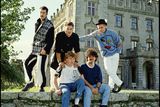Classical: Édouard Lalo - the man who lit up French music
Under the radar: Édouard Lalo was from Lille in France, but his main influence came from German composers.
It's a rejuvenated metropolis, the first stop on the Paris Eurostar from London, noted as the birthplace of Charles de Gaulle, another venue that will be etched into the memories of Irish football fans after Wednesday night's historic win. But since it's music that concerns us here, it should be noted that the city of Lille in northern France also gave us Édouard Lalo.
Édouard who? It's a fair enough question, for he doesn't get much of a mention in the standard reference books, and his music wouldn't be at the forefront of the most performed. That, though, is a pity, for there's a lot to enjoy in the compositions of Édouard Lalo.
He was born in Lille in 1823, into a military family that had its roots in Spain, which may have had a bearing on his output later. One of his most significant pieces is his Symphonie Espagnole, a violin concerto by another name, that got its first outing in the hands of the great 19th century virtuoso Pablo de Sarasate.
Lalo's talent was evident early, but his father was dead against him trying to pursue a career in music, so he effectively ran away, leaving home at 16 without any money, and heading for Paris. He managed to make a fist of it by playing and giving lessons.
Music was going to be his life. He got into the Paris Conservatory, and became one of the founder members of a professional string quartet, featuring alternately on both violin and viola, promoting a broad range of German music from Haydn and Mozart, to Beethoven, Schumann and Mendelssohn.
But nothing much was happening on the composition front, apart from a small collection of songs. It was only after he married, at the age of 42, that the music began to flow.
His wife Julie was a contralto, and he continued writing songs for her to perform, but he was branching out in other directions as well.
The five-movement Symphonie Espagnole sits alongside a violin concerto which he also wrote for Sarasate, and there's a cello concerto too.
Orchestration was his big thing, and in that respect he was more in tune with what was happening in Germany at the time than in France, where opera was all the rage. There are certainly similarities with the work of his contemporary Robert Schumann, for example.
Lalo did attempt two operas, the more famous of which is Le Roi d'Ys (The King of Ys, based on a Breton legend which was also used by Debussy as the basis of his piano prelude La Cathédrale Engloutie). Both of them fell at the first hurdle, initially rejected by the Paris Opera House, though they subsequently made it into the public arena.
It's significant that they're more memorable for the part the orchestra plays than the drama on stage, and the same can be said for Namouna, a ballet he was involved in, where the music dominated the choreography.
Despite his talent for the big set piece, Lalo's involvement in what was known as the Armingaud Quartet was evidence of his love for the more intimate confines of chamber music, and in this he was successful as a composer as well, writing for small ensembles and for the piano.
His smaller scale pieces may have had their roots in the output of the German composers he loved, but they hold a special place in the history of French music.
As the academic Georges Servières put it in his 1925 biography, the glory of Édouard Lalo was that he cast "a shaft of sunlight into French music" bringing "joy, life and chaste tenderness free of sentimentality, and burning passion without any unwholesome eroticism".
George Hamilton presents The Hamilton Scores on RTÉ lyric fm each Saturday and Sunday from 10am.
Join the Irish Independent WhatsApp channel
Stay up to date with all the latest news














